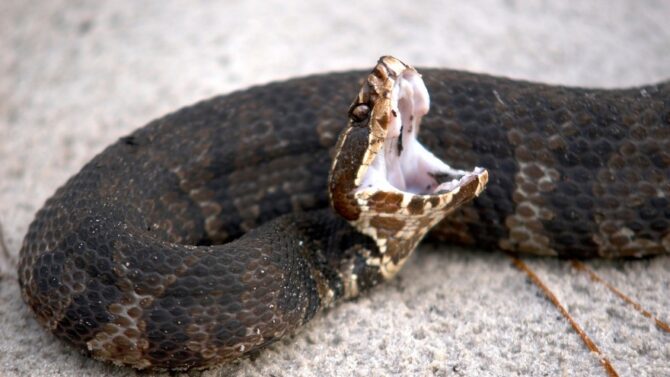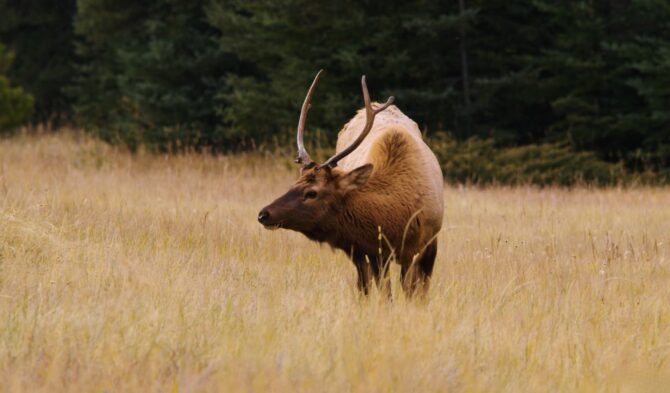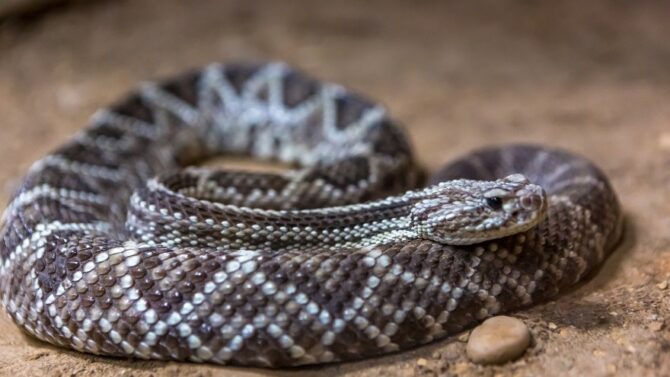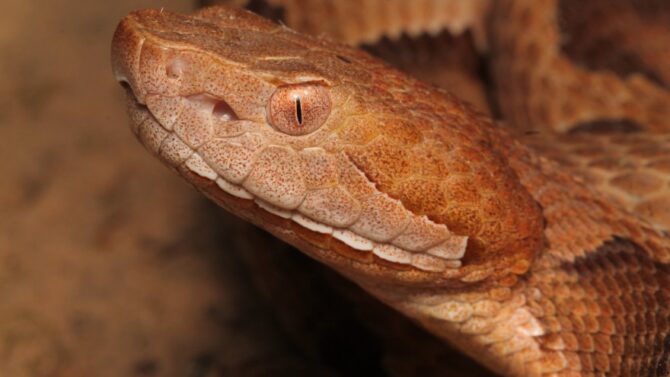Kentucky is a Southeastern state bordered by the Ohio River in the North. The state has a lot of wildlife which includes about 34 species of snakes.
Out of these, only four species are venomous snakes. The chances of getting bit are low in Kentucky.
However, care must be taken in the state, especially when outdoors, fishing, or hiking during the mid-spring and fall when snakes are more active.
The four venomous snakes in Kentucky are the copperhead, cottonmouth, timber rattlesnake, and western pygmy rattlesnake.
Let’s look into each of these poisonous species in detail.
The Most Venomous Snakes in Kentucky
1. Copperheads (Agkistrodon Contortrix)

- Size: 2-4ft
- Habitat: Forest, mashes, rocky water areas
- Identifying Features: Triangular heads, pits on both sides of their snots, set eyes, brown and other colors.
- Behavior: Secretive or shy, evasive, hisses loudly
- Threats: Severe pains, tingling, throbbing, swelling, nausea and vomiting, death.
The copperhead is one of the venomous snakes found in Kentucky. It is non-aggressive and rarely fatal.
Bites mostly happen when a human closely approaches this snake or accidentally steps on it.
The latter is easy as it blends well with its surrounding, which gives it the perfect camouflage. It is found mostly in the forest and water areas.
Though the fatality rate is low, copperheads should be avoided at all costs.
Bite symptoms include extreme pain, tingling, throbbing, swelling, nausea and vomiting, dizziness, paralysis, cardiac arrest, and death.
2. Northern Cottonmouth (Agkistrodon Piscivorus)
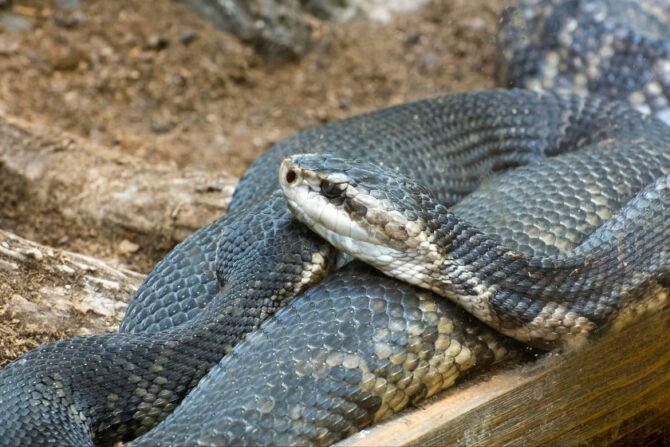
- Size: 30-42 inches
- Habitat: Streams, swamps, ponds
- Identifying Features: Thick body with colors like black and dark green, white cotton mouth.
- Behavior: Violent flight, rapid crawling, vibrating tails, tongue flickering, swimming.
- Threats: Dangerous bite, severe pains, swelling, damage to body tissues, excessive bleeding, no blood clots, amputation, death.
The Cottonmouth is another type of venomous snake found in Kentucky. It is more dangerous than the copperhead.
As an aquatic animal, it is mostly found near slow-moving water and shallow lakes.
Its color pattern consists of brown, gray, tan, yellowish-olive, or blackish-brown. It also has patches of white on the chin and an arrow-shaped head.
When threatened, the cottonmouth engages in a threat display that includes vibrating its tail and throwing its head back.
When it does the latter, it opens its mouth to display a white interior, hence its name.
It also hisses and flattens its body. A final threat display is the emission of strong secretion from the anal glands located at the base of their tail.
Cottonmouth bites are very fatal. The following symptoms can manifest: the destruction of tissues, skin discoloration, immense swelling, severe pains, and bruises.
Fishermen and swimmers are advised to beware of this fatal venomous snake.
3. Timber Rattlesnake (Crotalus horridus)
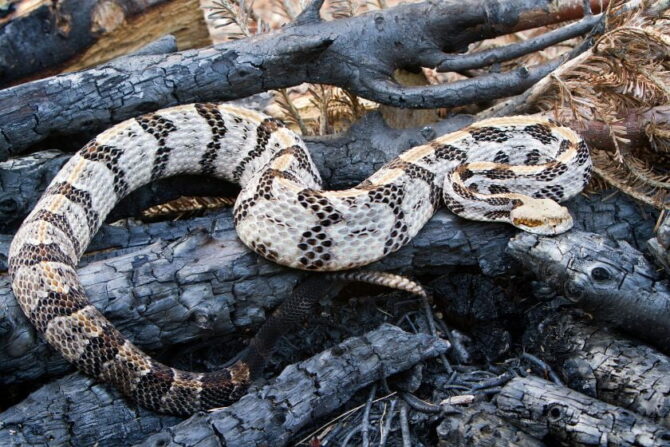
- Size: 60 inches
- Habitat: Rocky mountains, rivers, flood plains, lowlands, thick bushes, dense forest.
- Identifying Features: Rattle, thick body, dark or yellowish brown colors, blotches.
- Behavior: Nocturnal
- Threats: Dangerous bite, bleeding, cell death, skin discoloration, paralysis, cardiac arrest, numbness, death.
Timber rattlesnakes are also called canebrakes. These are the most venomous snakes in Kentucky and the second largest venomous snakes in the United States of America.
They have prominent rattles at the end of their tails with large bodies and angular heads.
Timber rattlesnakes are found in different habitats, like rivers, rocky mountains, and dense forests.
This snake’s venom contains neurotoxin and hemotoxin. Symptoms include pain, swelling, consistent bleeding, cell death, skin darkening, paralysis, numbness, blurred vision, and breathing difficulties.
If untreated, the venom can be fatal. Care should be taken when outdoors to be safe.
4. Western Pygmy Rattlesnake (Sistrurus miliarius Streckeri)
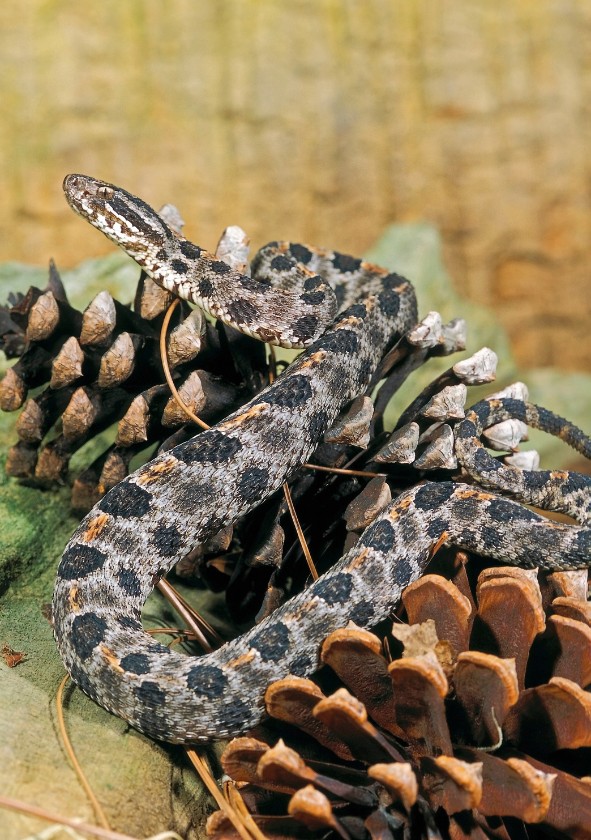
- Size: 15-20 inches
- Habitat: Sandhills, near rivers or lakes
- Identifying Features: Yellow tail with rattle, dark brown spots, black stripes, hollow fangs.
- Behavior: The sun itself makes a faint buzzing sound, coiling, jerking head.
- Threats: Painful bite, bleeding, redness, skin discoloration, paralysis respiratory disorder.
This is another species of rattlesnake found in Kentucky. However, it is rare in the state.
The western pygmy rattlesnake is small and is characterized by rattling sounds like insects.
Its distinguishing colors are gray base and orange with brown stripes running down the middle. Completing this is the brown blotches.
These snakes are mostly found in sandhills and near bodies of water like streams, swamps, and ponds.
In the face of perceived threats from predators, they apply defense mechanisms like coiling and rattles.
They are so secretive that only a few people encounter them, yet they can be dangerous.
Their venom, like that of other species of rattlesnakes, is fatal.
Symptoms include severe pains, bleeding, redness, skin darkening, paralysis, cardiac arrest, and death.
Conclusion
Generally, snakes only bite or attack humans when mistakenly stepped on or cornered, or felt threatened.
Therefore to be safe while in Kentucky, one should be careful both indoors and when outdoors, especially for fishers, swimmers, and hikers.
Finally, any bite from any snake should be treated as an emergency.
Up Next
- 15 Most Dangerous Animals In The United States
- The Most Venomous Snakes In North America?
- 10 Most Venomous Snakes In The World (Poisonous & Dangerous)
